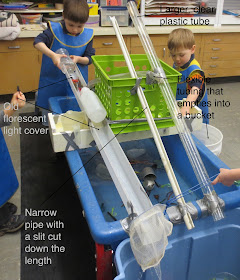The first thing they do is examine the worms. By the way, these are not real worms; they are plastic worms used for fishing. Some children will have not have anything to do with the critters. Most of the children do engage in various forms of inquiry, though. Watch how this boy investigates the worms.
Touching the worms from Thomas Bedard on Vimeo.
This child actually spent a long time at the table studying the feel and the properties of the worms. When he came back the next day, this is how he felt about the worms.
Then there are the worms and the tubes together. Since the worms are so flaccid, it takes a lot of concentration to get even one into the tubes that have narrower openings.
Sometimes the worm does not want to cooperative so it takes a lot of perseverance to deposit the worm in a narrow pipe. Watch.
The boy tries three times, but the worm does not go in. The video does not show it, but he eventually gets it in. An adult might get frustrated, but a child creates his own challenge and, with a lot a intricate fine motor work and perseverance, finishes the job.
Then there are the worms in the plastic chute (florescent cover). That has a wider opening so the children can and do pile the worms. In addition, the chute does not have a very steep incline. As a consequence, there can be a logjam of worms in the chute. How do you get them moving again? You begin by gathering a good quantity of water to pour into the chute. Watch how it works.
The amount of cooperation between the children is stunning. First, the two boys work together to fill the bottle and then the older boy pours the water and the girl with the net catches all the worms. Beside the cooperation, there was persistence on the boys' part and patience on the girl's part for the whole operation to be successful.
Sometimes it is trying to figure out where the worm comes out and where does it go.
Sometimes there is just the worms and containers. One of the preferred operations is to fill a bottle with worms and water.
The thing about the worms is that they are so squiggly so it takes a fair amount of fine motor work to get them in the bottle.
Sometimes it has nothing at all to do with the worms. Sometimes it is just about pouring and catching the water coming out of the tubes and chute. The thing is, there are as many ways of catching the water as materials on hand and the various inclinations of the children.
Sometimes it is the smallest container
Sometimes it is catching the drops with a bottle.
And sometimes it is catching the rushing water with a pail.
This is just a small sample of the children's play at the Worm Slide. It is as varied as the children who conceive it. The funny thing is this play looks like serious work that helps develop persistence, concentration, investigation, cooperation, communication, self-rgulation and a host of other important life skills. Does play drive the learning or are they one and the same?








No comments:
Post a Comment